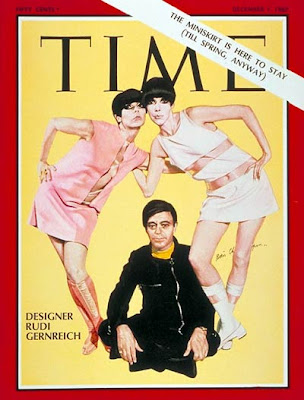Gay ThursDay: The Temperamentals

Gernreich, Rudi (1922-1985)
Along with British designer Mary Quant, Rudi Gernreich was one of the true avatars of 1960s fashion, responsible for thrusting haute couture into the mainstream of popular culture. His most famous--or infamous--contributions were the topless bathing suit (for women) and the no-bra bra.
Riding the crest of mod, psychedelic, and sex-centered fashion, Gernreich pioneered the use of cut-outs, plastics, and unisex styles. The contemporary image of 1960s fashion as symbolized by willowy models wearing brightly colored, vibrantly patterned, and revealing clothing owes much to Gernreich's contributions.
Gernreich was born in Austria on August 8, 1922. He and his mother fled Hitler's growing power by emigrating to the United States following the Anschluss of 1938. After studying art and a brief stint as a professional dancer, Gernreich began working in the fashion industry in the 1950s. While he achieved modest success, it was not until the swinging 1960s that his natural avant-garde tendencies were able to surface.
During the 1950s Gernreich made his mark in the fashion world by designing the first unstructured women's swimsuit, a form-fitting one-piece with no wire or other supports. In 1964 he one-upped himself with the topless bathing suit. Basically a classic one-piece women's swimsuit, Gernreich cropped it just above the waist and supported it with a V-shaped pair of thin, over-the-shoulder straps, thus exposing the breasts on either side.
Initially a purely artistic statement devised in response to both his own and rival Italian designer Pucci's predictions about the future of womenswear, the design became an unexpected commercial hit and international scandal. It took the exposure of female flesh pioneered by Mary Quant's mini-skirt to the next logical step and became a couture emblem of the 1960s sexual revolution.
Gernreich immediately followed up the success of his topless bathing suit with a more practical and permanent innovation: the no-bra bra. Instead of using rigid supports and padding, Gernreich conceived a soft, minimal skintone bra that went along with the often unstructured styles of the time, as well as with the many sheer fabrics and plunging necklines. Variations on this design are taken for granted as basic lingerie more than thirty years later.
Among Gernreich's other innovations was the use of cutouts. In both swimwear and other designs he utilized provocative and erotic cutout areas in the side, back, front, and elsewhere. Similarly, he sometimes used transparent plastics for the same effect, and was among a group of 1960s designers responsible for the integration of plastics and other new materials into clothing. Like many others in the 1960s, Gernreich exploited brilliant new colors and psychedelic patterns sometimes inspired by Op Art and other 1960s trends.
In the 1970s, Gernreich again became a controversial pioneer, this time for his exploration of unisex fashion, which he carried to an extreme by using identical clothing on totally hairless male and female models. In 1974 he designed what were--arguably--the prototypes of the thong swimsuits that became famous years later.
Ultimately, Gernreich was one of the great modernists of fashion design, always thinking about the future and making his clothes consciously futuristic both technically and stylistically.
In some ways Gernreich was ahead of his time in his attitude about his homosexuality as well. On the one hand, he had to remain relatively closeted in accordance with the customs of the time. On the other hand, he never seemed to consider it much of an issue in the first place. Paradoxically, however, after his death it was revealed that Gernreich was actually a founding member of the Mattachine Society in the early 1950s.
Gernreich's participation in the pioneering homophile gay rights group was likely caused by his year-long relationship with radical activist Harry Hay in 1950-1951. He left the group when Hay did in 1953.
Gernreich's association with the Mattachine Society was kept quiet by Hay until the designer's death. However, the posthumous establishment of an endowment at the American Civil Liberties Union by the estates of Gernreich and his life-partner Oreste Pucciani, a Professor of French at UCLA, for the purpose of education and litigation in the area of gay civil rights, suggests an underlying political commitment to change that is equivalent to his more public innovations in fashion.
[source: Joe A. Thomas, There is a lot going on on this site]

Perhaps this should be about Michael Urie's status as an out gay actor as some would have it ... and there's nothing wrong with that. He is starring in a very important play about Rudi and his one time lover, Harry Hay. Go see it--click here. Perhaps the impact that Michael is making will have an impact on him.

Comments